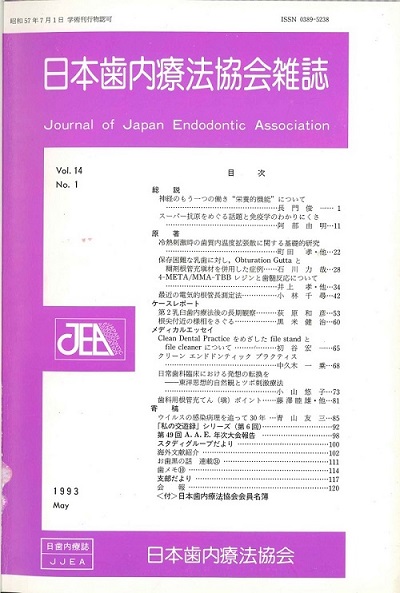Various factors are required to be taken into consideration for a successful endodontic treatment. Of these factors, the most important one appears to be an accurate measurent of the root canal length. Without this measurment being made, no accurate lengths an endodontic treatment work can be determined and therefore the treatment will naturally become a hit or miss resulting in under- or over-instrumention, under- or over-filling, and the efforts of dentists are not properly rewarded.
Those authors developed the Sono-Explorer utilizing low-frequency oscillation in 1972, and has demonstrated as a thorough experiments conducted so far that root canal lengths can be accurately and electrically measured. In the following, those authors will make a report on a follow up study of the results of the endodontic treatment basad on the measurement of root canal length by this method.
In this experiment, lengths of 66 infected root canals which had undergone periapical pathosis before the treatment were accurately measured by the Sono-Explorer before root canal filling. Furthermore, for the purpose of comparison with the results achieved by other reporters, filling within 0~-1.5mm from the root apex when examined by X-ray photographs was defined as flush filling, withtn −1.6~−3.0mm as underfilling, and within +0.1~+1.5mm as overfilling.
The following conclusion was obtained as a result of examination of the results over time intervals of from 1 months to 20 years on the basis of the examination of X-ray photographs.
1. In the case of root filling which were regarded as underfilling or flush filling, apical radiolucencies began to be recognized in one month after filling, and the rate of apical radiolucencies increased with the passage of time. However, in the cases of which was regarded as cases of overfilling, it took time until that apical radiolucencies were recognized, and in some cases no apical radiolucencies appeared.
2. So far as the conditions of root canal filling as examined by X-ray photographs were concerned, the rate of successful treatment was 90.4% for underlining. 94.5% for flush filling and a low 50% for overfilling. Thus, there was no much difference between underfilling and flush filling, but there was a significant diffence between these and overfilling.
3. Generally speaking, the rate of successful root canal filling was 87.8% for the cases of filling which did not exceed the apical foramen but reached the apical constriction, and 95.3%, in the cases of filling in which the apical radiolucencies were occurring, are included. Furthermore, excluding the cases of intentional overfilling, the rate was as high as 98%.
4. The electric root canal measurement method is more accurate than the X-ray measurement method, and an accurate measurement of root canal length is considered a major key to a successful endodontic treatment.
View full abstract
